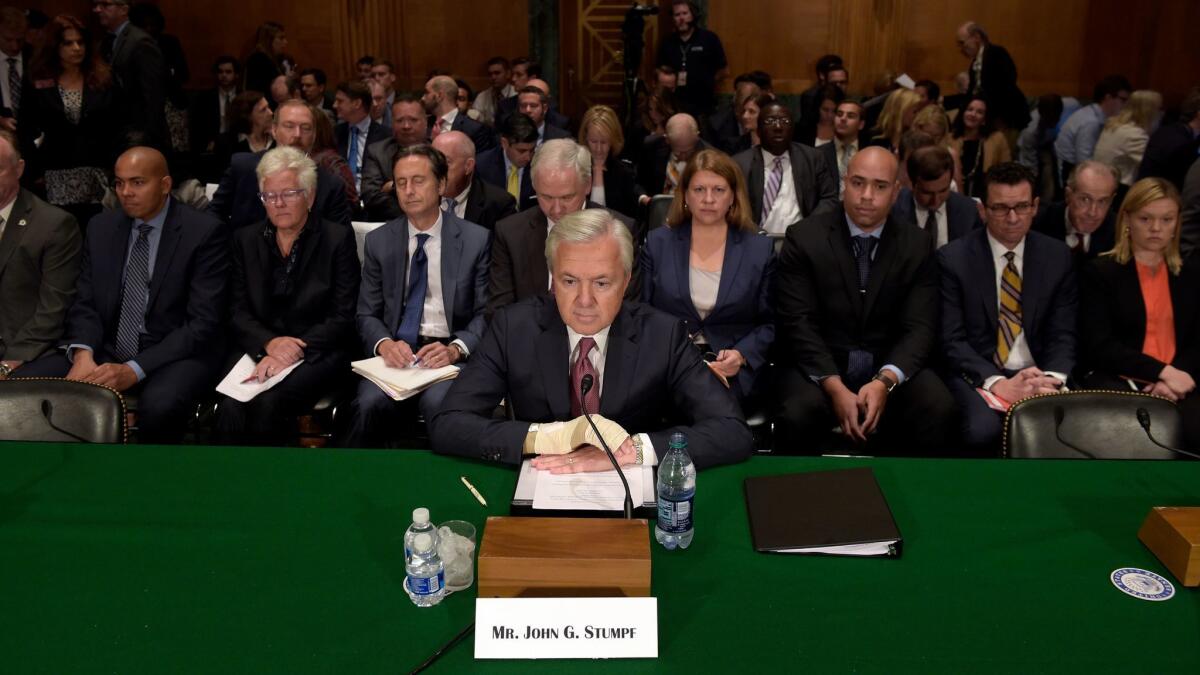Column: Wells Fargo scandal report details board of directors’ dereliction of duty, but gives them a pass

The independent investigation report into the Wells Fargo fraudulent account scandal, released early Monday, already is being described as “scathing,” and properly so. On the whole, however, the report deserves a different description: It’s a whitewash.
The scathing part applies largely to the report’s treatment of former Wells Fargo executive Carrie Tolstedt and former Chairman and CEO John Stumpf. Tolstedt led the retail banking division where the problems occurred largely because she imposed crushing sales quotas that prompted employees to open thousands of bogus accounts for existing customers to meet their numbers. The 113-page report, prepared by the law firm Shearman & Sterling, relates how Stumpf nurtured and protected Tolstedt even as evidence mounted that her division’s behavior posed an enormous risk to the company.
The whitewash part applies to Shearman & Sterling’s employer, the board of directors. According to the report, efforts by board members to bring Tolstedt and her division to heel were thwarted by management’s failure to provide accurate information about the unfolding scandal.
Throughout 2015 and 2016, the Board was regularly engaged on the issue; however, management reports did not accurately convey the scope of the problem.
— Wells Fargo scandal investigation
Sorry, that won’t do. A careful reading of the report reveals a board that took months, even years, to get its arms around the scandal despite plenty of warnings about its nature magnitude. These include an investigation by The Times in December 2013 and a lawsuit filed by Los Angeles City Atty. Mike Feuer in May 2015.
Despite these and other red flags, the board indulged Stumpf in his support of Tolstedt. Even after Timothy Sloan — now the bank’s CEO — became chief operating officer and Tolstedt’s immediate supervisor in November 2015, the board acceded to his request to take six months to assess her performance. But by then the board knew very well that Tolstedt’s management was leading the company toward disaster.
The result of its dithering was the nuclear explosion of a $185-million settlement with Feuer and federal regulators last September, followed by multiple congressional investigations, Stumpf’s resignation and continuing doubts about Well Fargo’s integrity by banking customers.
As my colleague James Rufus Koren reports, Wells Fargo has responded to the investigation by moving to take back more than $47 million in pay from Tolstedt and $28 million from Stumpf. That’s in addition to $41 million in stock awards for Stumpf and $19 million for Tolstedt that have been canceled.
Yet while acknowledging that board members were too tolerant of management even when it became clear that they were being snowed, the Shearman report is silent about whether the directors, not just senior executives, should be forced out or their compensation clawed back.
That’s an important issue, because some of the directors have served since the 1990s. They’ve been collecting an average of $300,000 a year for their, er, “service.” Management has renominated for a new term all the current directors who were in place as the scandal took hold with the exception of Elaine Chao, who has become secretary of Transportation, and Susan Engel, who has stepped down.
The investigation report depicts the board as almost entirely supine as Stumpf and his management team obfuscated and tried to explain away emerging information about the bogus-account scandal — some of which cropped up even before The Times’ article.
“Throughout 2015 and 2016,” the report states, “the Board was regularly engaged on the issue; however, management reports did not accurately convey the scope of the problem.”
In February 2013, the consulting firm McKinsey was hired to examine the bank’s risk management. McKinsey’s performance was an outstanding demonstration of the worthlessness of management consultants: The firm produced a 402-page report that the Shearman investigators say “identified the need to “manage...the risks associated with sales,’” but “without further description of the actual problems.”
According to the investigation, board member Enrique Hernandez Jr., chairman of its risk committee, took a proactive stance in trying to learn about the sales misdeeds and criticizing Tolstedt. He and his committee members didn’t get much support from the rest of the board, the investigators imply, even after Hernandez concluded that Tolstedt had been “intentionally misleading the board.” In 2016, the report suggests, Stumpf fought a board effort to cut her compensation — and won the battle.
The fundamental flaw of the Shearman & Sterling investigation is its failure to come to grips with the duties of the board of directors. This isn’t unique to Wells Fargo; almost any corporate scandal can be traced to some degree to a board unwilling or unable to perform its function of riding herd on management.
One aspect to the problem at Wells Fargo is evident on the very first page of the report’s text, which lists the four “independent” directors who were constituted as an oversight committee to supervise the investigation. Of the four — Elizabeth Duke, Donald James, Hernandez and Stephen Sanger (now the Wells chairman) — only Duke joined the board after the scandal (in 2015). Hernandez and Sanger became directors in 2003 and James in 2009, so the scandal occurred on their watch.
In business parlance, “independent” directors are those who aren’t members of management, but can directors who have been in place for 14 years or even eight really be judged “independent”? It’s doubtful; after a certain period many directors begin to identify themselves with management and lose the urge to confront their CEOs.
But that’s exactly their duty. The only acceptable conclusion the investigators could have come to is that the directors, like Stumpf and Tolstedt, had to go. For many, many years, they didn’t earn their pay.
Keep up to date with Michael Hiltzik. Follow @hiltzikm on Twitter, see his Facebook page, or email michael.hiltzik@latimes.com.
Return to Michael Hiltzik’s blog.
UPDATES:
12:57 p.m.: This post has been updated to clarify that Wells Fargo will claw back an additional $47 million in compensation from former executive Carrie Tolstedt and $28 million from former CEO John Stumpf.
More to Read
Inside the business of entertainment
The Wide Shot brings you news, analysis and insights on everything from streaming wars to production — and what it all means for the future.
You may occasionally receive promotional content from the Los Angeles Times.











